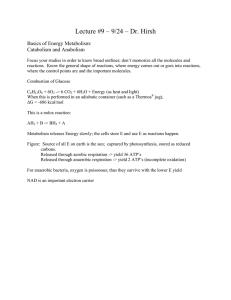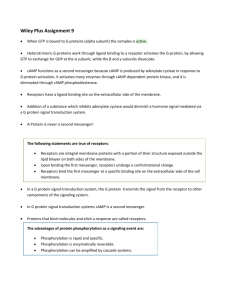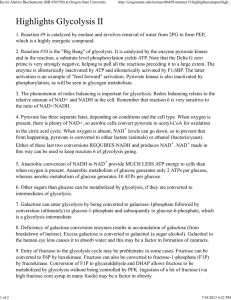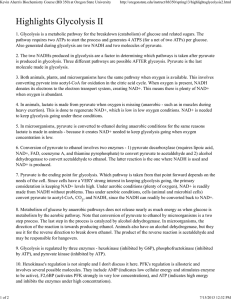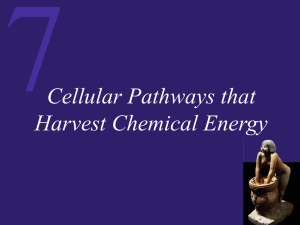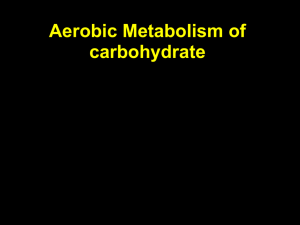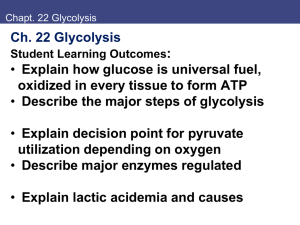Chapter 7 - Harvesting Chemical Energy
advertisement
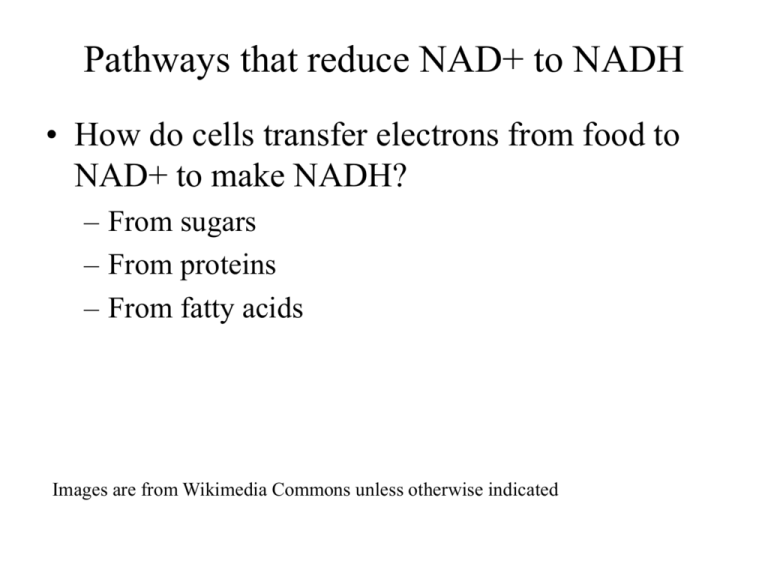
Pathways that reduce NAD+ to NADH • How do cells transfer electrons from food to NAD+ to make NADH? – From sugars – From proteins – From fatty acids Images are from Wikimedia Commons unless otherwise indicated Oxidation of glucose to CO2 Glycolysis Pyruvate oxidation Citric acid cycle http://www.biologie.uni-hamburg.de/b-online/e19/19d.htm Glycolysis: partial oxidation of glucose to pyruvate Glycolysis – in cytoplasm of all cells 1. Uses 2 ATPs to “activate” glucose 2. Splits glucose into two 3-carbon sugars 3. Partially oxidizes the sugars, yielding 2 NADH per glucose 4. Substrate-level phosphorylation of ADP to make 4 molecules of ATP 5. Nets 2 pyruvates, 2 ATP, 2 NADH In respiring cells, pyruvate is oxidized to CO2 + acetyl CoA http://www.micro.siu.edu/micr201/chapter8N.html Two molecules of pyruvate are oxidized to 2 acetyl CoA + 2CO2, generating 2 NADH per molecule of glucose. Citric acid cycle generates ATP, reduced electron carriers and oxidizes acetate to CO2 Campbell & Reece Biology 8th ed. Fats and proteins http://www.ruf.rice.edu/~bioslabs/studies/ mitochondria/mitokrebs.html http://www.life.umd.edu/classroom/bsci424/BS CI223WebSiteFiles/GeneralCatabolism.gif Locations of eukaryotic energy pathways Campbell & Reece Biology 8th ed. Respiring cells make most of their ATP via oxidative phosphorylation. What happens in the absence of respiration (no electron transport chain function)? Fermentation reduces pyruvate to lactic acid or ethanol, to regenerate NAD+ from NADH 2 ADP + 2 Pi Glucose 2 ATP Glycolysis 2 Pyruvate 2 NAD+ 2 NADH + 2 H+ 2 CO2 2 Acetaldehyde 2 Ethanol (a) Alcohol fermentation 2 ADP + 2 Pi Glucose 2 ATP Glycolysis 2 NAD+ 2 NADH + 2 H+ 2 Pyruvate 2 Lactate (b) Lactic acid fermentation In the absence of respiration • Cells can make ATP through glycolysis and fermentation of glucose • Cells cannot run pyruvate oxidation or citric acid cycle (no mitochondrial function in eukaryotes)




